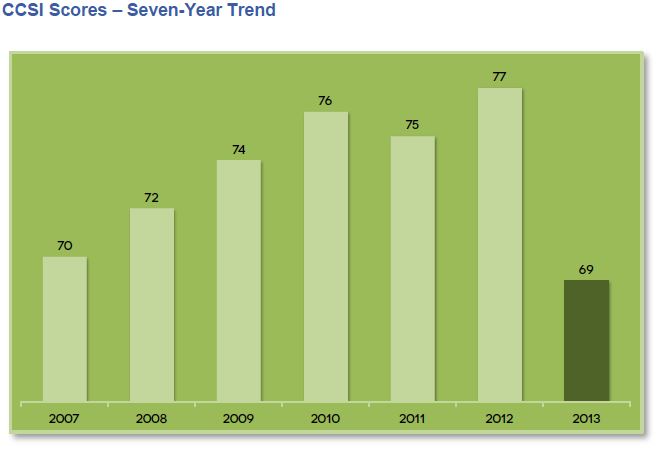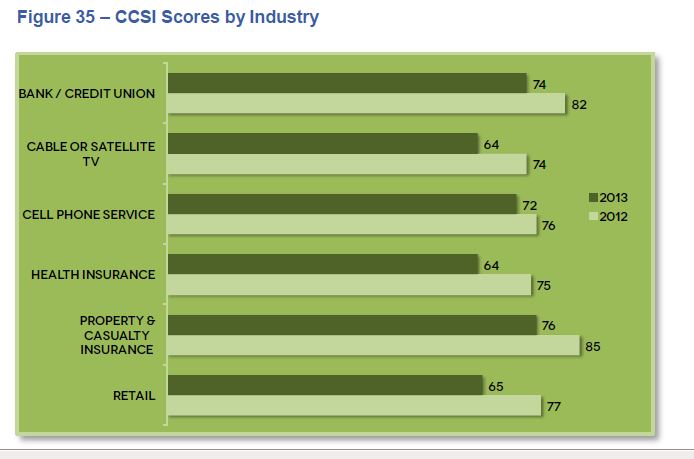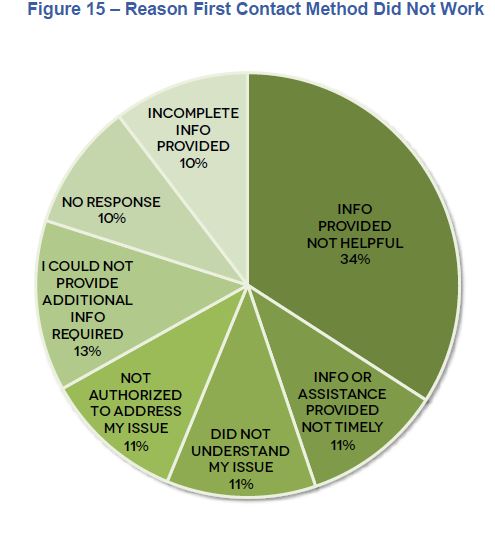Hardly a day goes by without an item about how improving the customer experience is now the intense focus of C-levels globally. In fact, the job of chief customer experience officer, or a title very similar, is arguably the fastest growing C-level position in enterprises around the world. The reasons are obvious. They are also what are driving the adoption of new contact center solutions and the use of big data analytics as enterprises large and small seek to create sustainable advantage by enhancing how they interact with all of us.
One would think that all of this attention would lead to customer satisfaction ratings that were on the rise. Unfortunately, the CFI Group's Contact Center Satisfaction Index, now in its seventh year, tells a different story. In fact, the recently released index finds customer satisfaction with contact centers “dropped a whopping 10 percent in 2013.” In addition, as CFI Group notes, with a score of 69 (on a 100 point scale), the 2013 score reflects an eight-point pull back from the record high of 77 in 2012.
There is a lot of grumpiness out there
The 2013 CCSI collected data from more than 1,500 consumers across six major industries: banking, cell phone service, health insurance, property insurance, retail, and cable or satellite TV. The 38-page report documents with incredible granularity the growing dissatisfaction with contact center interactions in the sectors covered. It also provides theories on what is going on along with pointers on what can be done to reverse the downward trend as depicted in the seven-year look.

"With such a large drop in customer satisfaction, companies need to focus on improving their contact center's policies and procedures currently in place as they look for ways to return to prior year's satisfaction levels," says Terry Redding, vice president of marketing and product development for CFI Group. "This focus will aid more than just scores; it is vital from a company profit perspective as satisfied customers buy more and recommend the companies to others more frequently, all of which contributes to the bottom line."
Beyond basic policies and procedures, CFI Group sees two explanations for the drop.
- Consumers have low confidence with the economy and government and are generally fatigued as the economy continues to stall, leading to the score backlash.
- After years of steady growth in performance, consumers have built an expectation of great service, and contact centers failed to meet it this year.
Interestingly, the report shows there are ways for contact centers to increase satisfaction, especially through the use of non-call channels. In fact, one of the key findings is the growing desire for self-paced help. This is an area where almost half of respondents said their preferred method of contact would be a non-call communication, such as e-mail, chat or via the company's website. Chat in particular is singled out with 63 percent of this year's respondents saying they actively look for the chat function when visiting a company's site.
"As non-call channels continue to grow in use and popularity, now is the time for contact centers to begin training, testing and monitoring these channels for improvement in the customer's experience," says Redding. "To better serve customers, companies need to continue to look at the service aspect of their website with an eye toward customer self-service and not just traditional marketing and sales activities."
The CCSI also found that social media is growing as an avenue for customers to share and voice opinions in a community setting and for businesses to conduct damage control. Nearly 40 percent of respondents turned to social media to voice a concern, increasing from 17 percent of respondents in 2012.
"Successful companies are monitoring this channel and reaching out to consumers through the same social media to address consumer issues. When done successfully, companies are seeing the payback as the study shows significant increases in customer satisfaction, loyalty and likelihood to recommend as a result of these efforts," says Redding.
As noted, there is a real trove of valuable information and insights in the report. The two charts below are indicative of this. The first shows that the decline is evident in all industry segments surveyed.

CFI Group Contact Center Satisfaction Index 2013
The second is part of a series that delves into the customer experience and breaks down why first contacts fail.

The report goes into several important areas including: satisfaction drivers and how improvements can raise sat scores; reasons why people reach out to contact center support in the first place; the way people currently contact enterprises and the shifting nature of this as those non-call channels become more important, especially in terms of what becomes the first point of contact; and looks at each channel of interaction (call, IVR, chat, e-mail, website, Facebook (News - Alert) and more) and their impact on moving the bar back up.
CFI Group concludes from its analysis of the data a few points to consider:
- People want options beyond the phone.
- First call resolution is everything.
- Chat as a service channel is growing, especially with Millennials.
- Social media is used as damage control, i.e., it is not the primary way people wish to interact but is where they vent and thus needs to be monitored closely for brand protection.
- Offshore contact centers remain a problematic area, particularly as people’s expectations continue to rise. Their patience gets shorter, and alternatives for future business are widely available.
There is a nice quote at the start of the index that really says it all: “In the growing environment of continuous connectivity, contact centers have become, for many, the primary face of the companies we do business with – always there, always on, and always expected to deliver on the company promise.”
Making the contact center the brand ambassador, hence improving the technology and the skills of the people who are the front line of customer interactions, has taken on increased importance.
The advent of social media and the ability to make bad experiences viral along with rising expectations, fickleness and instant availability of alternatives, are why all of those CCEOs have been put in place. This is clearly a report that they are going to find illuminating to say the least.
Edited by Stefania Viscusi



